Capsicum annuum ‘Serrano’
Looking for more heat than jalapenos offer, but you don’t want a pepper so spicy it will melt your tastebuds? Hello, serrano!
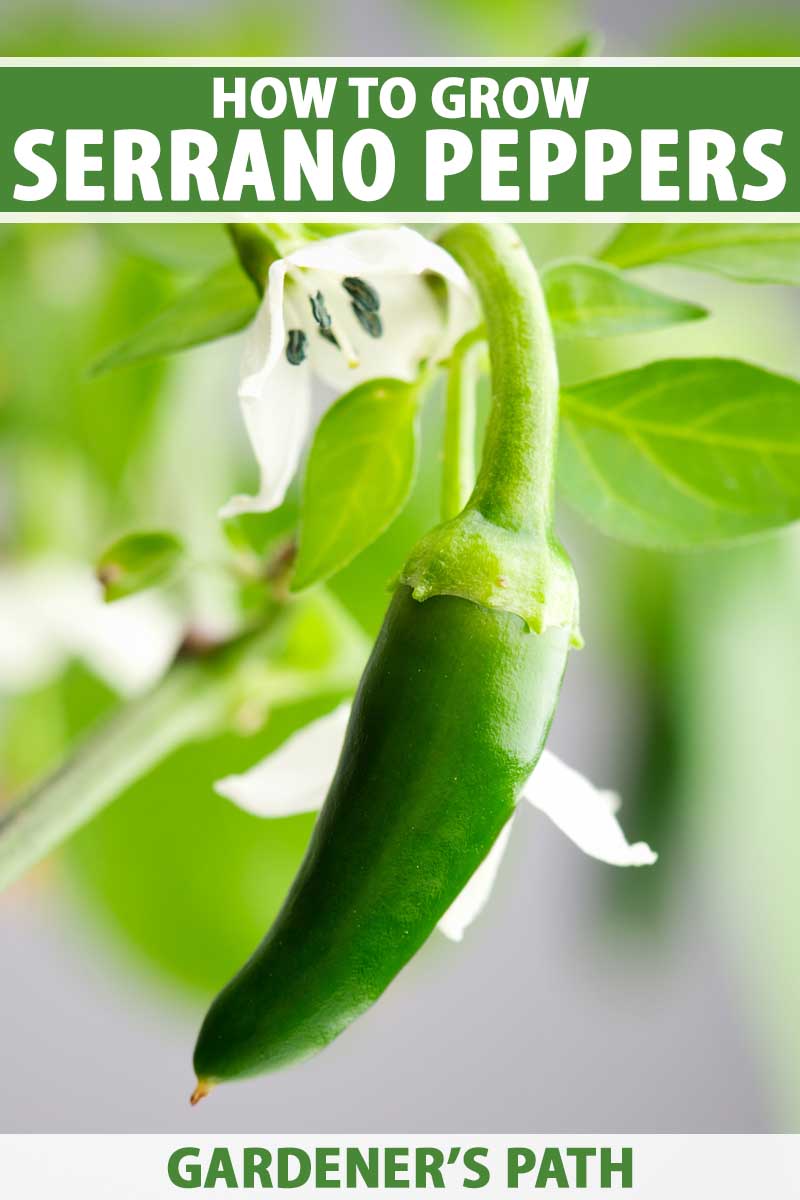
We link to vendors to help you find relevant products. If you buy from one of our links, we may earn a commission.
These peppers are popular for a reason. The good amount of heat they offer doesn’t overpower their pleasant grassy flavor, and the juicy flesh is the perfect thing for salsas and sauces.
You can cook with them or eat them raw right off the plant. Either way, you’re in for a treat.
Growing serranos yourself gives a measure of control over the heat level and you can decide whether to harvest them young and green, or wait until they’re mature and red when the spiciness has mellowed a bit.
We’ll cover all the tricks to know when growing this staple of Mexican cuisine. Here’s what to expect:
What You’ll Learn
Serranos are a staple in my kitchen and garden, and I can’t imagine a summer without the opportunity to pluck them straight off the plants. So let’s not wait any longer to start growing!
What Are Serranos?
Serrano peppers are part of the Capsicum genus. Botanically, serranos are chilies, not peppers. True peppers are plants in the Piper genus, with black pepper – the one we harvest black pepper seasoning from – being perhaps the most famous.
Why do we call chilies “peppers?” As with many naming errors, this goes back to Christopher Columbus.

When he and his crew arrived in the Americas, they encountered the domesticated plants and likened them to the Piper plants with which they were familiar in Europe.
Despite the misnomer, we’ll refer to peppers and chilies interchangeably as plants in the Capsicum genus in this guide, since that’s how most people know them.
The plants can grow up to five feet tall, but I’ve never had one reach more than half that. Even still, you can easily harvest four dozen or more fruits off of one plant in a season.
Serranos are typically eaten when they’re green. The fruits grow between one and four inches long and about half an inch wide.
If you leave them to mature on the plant, they’ll turn red, yellow, brown, or orange. They’re long and tapered, and look similar to a jalapeno but with a pointier tip. They have thick flesh and thin skins, with a grassy, spicy flavor.

To help pepper lovers understand how much capsaicin (and thus how much heat) a chili has, we use the Scoville heat units (SHU) scale. Serranos come in at 10,000 to 30,000 SHU.
For comparison, bell peppers are zero SHU, and jalapenos rate between 2,500 and 8,000 SHU.
Serrano peppers are below cayenne peppers, which are between 30,000 and 50,000 SHU, and far below the violently spicy (and delicious!) ‘Carolina Reaper,’ which rates at an astounding 2.2 million SHU.
Beyond the heat, serranos are set apart from many other peppers out there in that they have a lot of flesh. That makes them ideal for making juicy creations like salsa.
Cultivation and History
All plants in the Capsicum genus are native to the southern part of North America, the northern part of South America, and the Caribbean.
Serrano peppers hail from Mexico, where they are the second-most popular pepper after jalapenos.
They originated in the mountainous states of Hidalgo and Puebla, and their name is derived from the word sierra, the Spanish term for “from the mountains.”
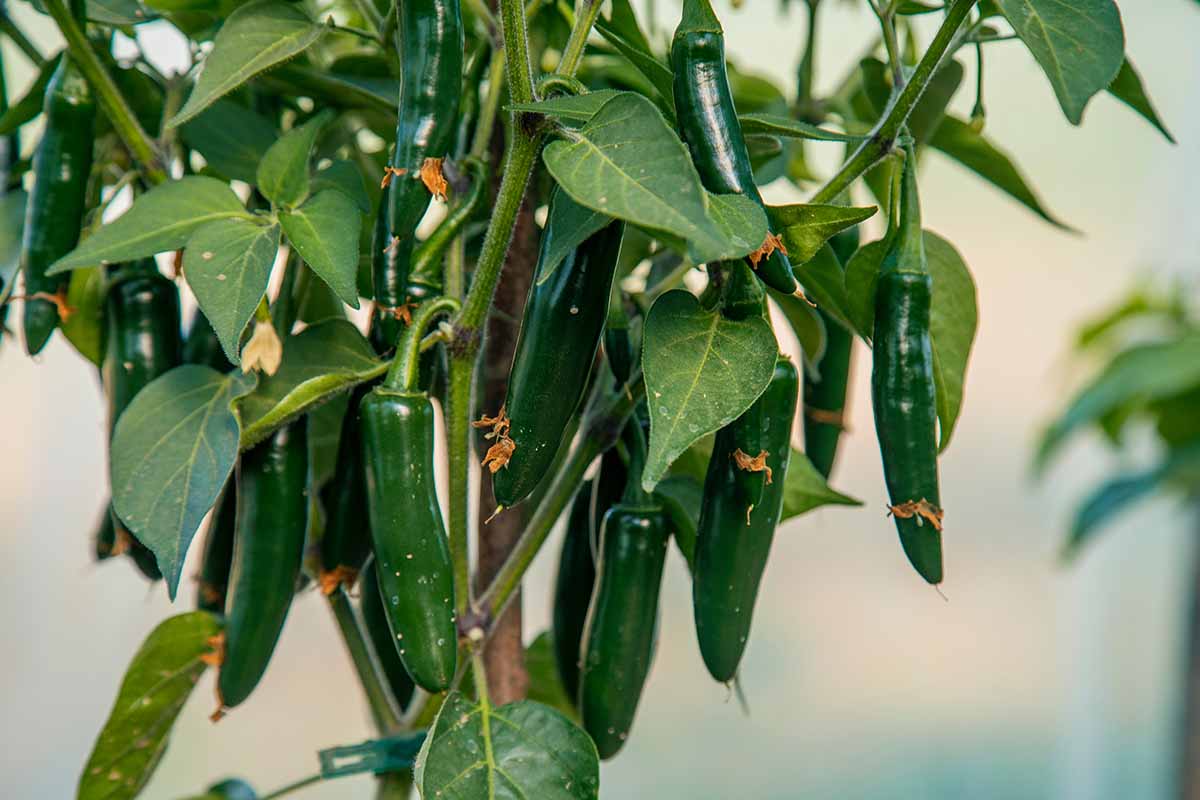
In the US, serrano sales take a distant backseat to jalapenos, but they’re still one of the most popular chilies.
Anecdotally, most of my Mexican friends and family have stopped buying jalapenos as much as they used to, and are turning to serranos instead.
That’s because the jalapenos commonly available in grocery stores are usually milder and larger than they used to be in the past.
If you want to be sure that you’ll get some spice and you don’t have a reliable source for hot jalapenos – or your own plant – serranos are a good substitute.
Most gardeners grow serranos as summer annuals, but they can be grown as perennials in warmer zones. More on that a bit later, so keep reading!
Propagation
If you decide to propagate seeds from the fruits of plants you have grown yourself, keep in mind that peppers cross-pollinate incredibly easily.
If you had a bell pepper plant and a serrano plant growing near each other last year, the seeds from the serrano fruits might not produce the results you expect.
This ability to cross-pollinate is one of the reasons why we have so many fabulous varieties of peppers to choose from today, but it can also present a gardening challenge.
If you need to be absolutely certain that you’re planting the cultivar you want to be growing, purchase seeds or seedlings, or make sure your plants are well isolated from one another.
From Seed
Peppers are fairly easy to start from seed, provided you have bright light (or supplemental lighting) and a heat mat. If you have both, then start prepping about eight weeks before the last predicted frost date in your area.
If you need to pick up a heat mat, Vivosun makes a reliable option that is adjustable, unlike some other mats on the market.

Use a compostable peat pot, or even better, choose manure pots instead. CowPots are made out of an extremely renewable resource (cow poop) and they biodegrade right into the soil when you plant them, adding nutrients and leaving no waste behind.
Use a three-inch six-cell or individual three-inch pots. If you’re looking for a good place to pick them up, Arbico Organics carries CowPots in both sizes.
Fill the pots with seed-starting mix and place a seed a quarter-inch deep in the medium in each cell or container.
Place on a heat mat where the seeds will be able to receive at least 12 hours of light a day, preferably 16 hours, once they germinate. This might mean using grow lights is necessary.
Keep the soil moist but not wet as the seeds germinate and the seedlings emerge. This will take about two to three weeks.
When the outdoor nighttime low temperatures are around 50°F and the seedlings have at least two sets of true leaves, you can transplant your peppers outside after hardening them off.
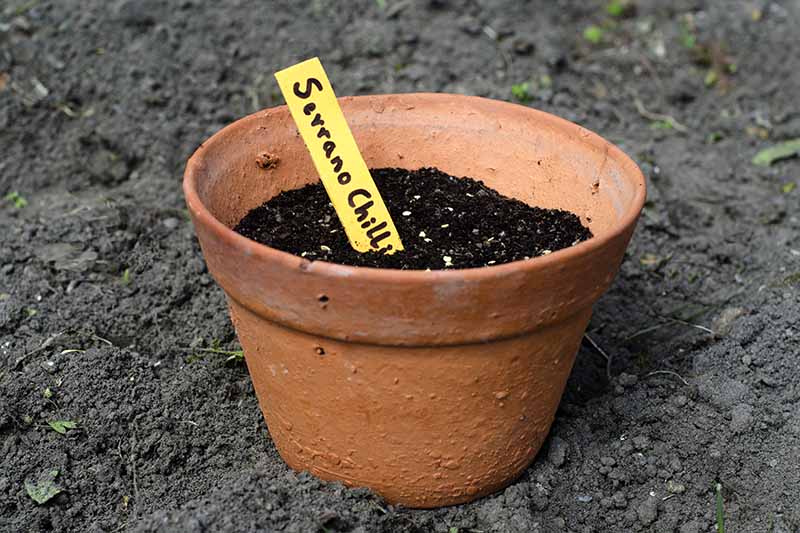
Hardening off involves placing the seedlings outside in a protected area with dappled sunlight for an hour and then bringing them back into the safety and more mild conditions of home.
The next day, give them two hours in the great outdoors. Keep adding an hour each day until a week has passed. Now you can plant them in the garden.
From Seedlings
I don’t know about your neck of the woods, but around here, there aren’t that many pepper seedling cultivars available at my local stores. Fortunately, serranos are always part of the selection. Planting them is straightforward.
Amend your soil, if necessary, by adding sand and lots of well-rotted compost. Peppers like sandy, well-draining soil, while heavy clay is a chili killer. You will need to amend the soil at least two feet down and wide.

Then, dig a hole just slightly wider and the same depth as the container that you started your seeds in or that the plant came in. Gently loosen the plant and remove it from its pot.
Place the seedling in the hole that you dug. Of course, if you grew your own peppers in biodegradable pots, there’s no need to remove them from the container.
These plants need about 12 to 18 inches between them to grow to their full size without being too crowded. Crowded plants are more susceptible to pests and diseases.
Serranos can also be grown in three-gallon containers, though a five-gallon capacity is preferable. Be sure to choose one with a drainage hole in the bottom.
Water the soil well until it is saturated but not muddy. Keep young plants moist and gradually reduce watering as the plant matures.
How to Grow
Once your plants are in the ground, water them regularly so the soil’s moist but not wet. When the top inch of soil dries out, it’s time to add more water. Water is especially important when plants are young, and up until the fruits form.
Mulch is extremely helpful when growing chilies. Place an inch of straw or compost around the plant, but leave an inch free around the circumference of the stem.
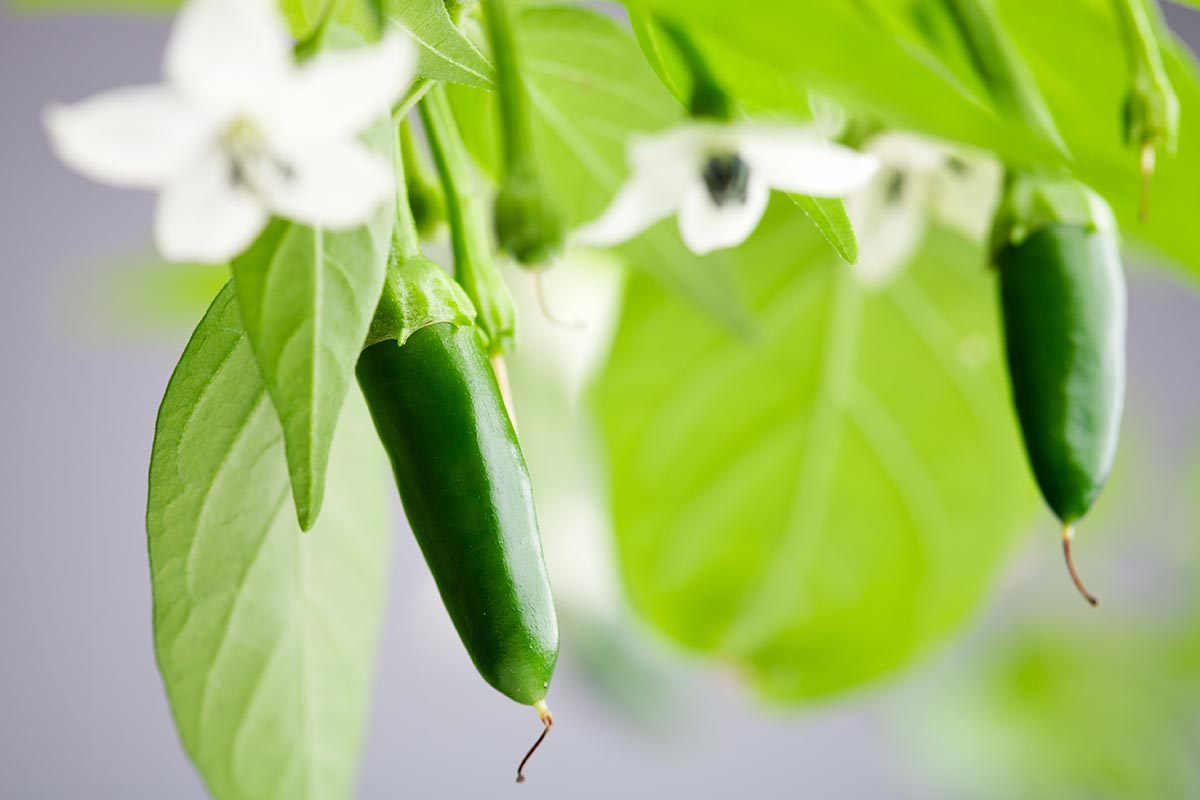
Remember, peppers come from places that are nice and hot. Don’t even think about subjecting them to temperatures below 50°F.
If you have a surprise weather event that threatens a dip in temperature, cover your plants with a blanket or cardboard. Floating row covers can help to regulate temperatures in areas that tend to experience fluctuations.
If you live in an area that doesn’t have extremely warm summers, you might want to place your peppers somewhere they can receive heat that’s reflected off of a building. Brick is ideal for this.
That’s what I do in the mild Pacific Northwest climate where I live, and the south side exposure right next to a brick wall is ideal.
If you live somewhere where temperatures regularly climb above 80°F during the summer, any spot with at least eight hours of sun per day is fine.
If you like your peppers spicy, there are a few things you can do to ensure extra heat:
- Feed plants with a high-nitrogen fertilizer.
- Reduce watering after the fruit has set – water when leaves just start to droop, but not before.
- Let the peppers reach their mature size (around 70 days) and then harvest. They shouldn’t be left to mature further on the vine. Once the color starts changing from green, the pepper starts becoming milder.
Typically, growers recommend a low-nitrogen fertilizer with something in the range of 5-10-10 NPK to encourage fruit formation rather than foliage.
That’s excellent advice if your goal is to grow lots of peppers with a typical spiciness level. The recommendation to use high nitrogen only applies if your goal is to increase the heat.
For high nitrogen, something like Down to Earth’s Bat Guano is ideal.
Arbico Organics carries this option in quarter-, two-, or ten-pound boxes.
For low-nitrogen fertilizer, choose something labeled as vegetable or fruit fertilizer.
AgroThrive Fruiting & Flowering Fertilizer
Once again, Arbico Organics carries a good option with AgroThrive’s Fruiting & Flowering Fertilizer. It comes in 32-ounce or gallon containers.
With either option, follow the manufacturer’s directions for timing and amounts to use.
Growing Tips
- Water after the top inch of soil dries out.
- Mulch around plants to retain water and suppress weeds.
- Protect peppers from temperatures below 50°F.
Pruning and Maintenance
If you live in Zones 9b to 12b and you plan to grow your plants as perennials, prune them hard during the winter. You want to prune them back by half.
If the temperatures dip below 35°F, bring them indoors or cover them in blankets or cardboard. Our guide to overwintering peppers has more information.
In the second year, you’ll likely see a big, bountiful harvest. The number of fruits that grow on your plant will start to decline in the third year.
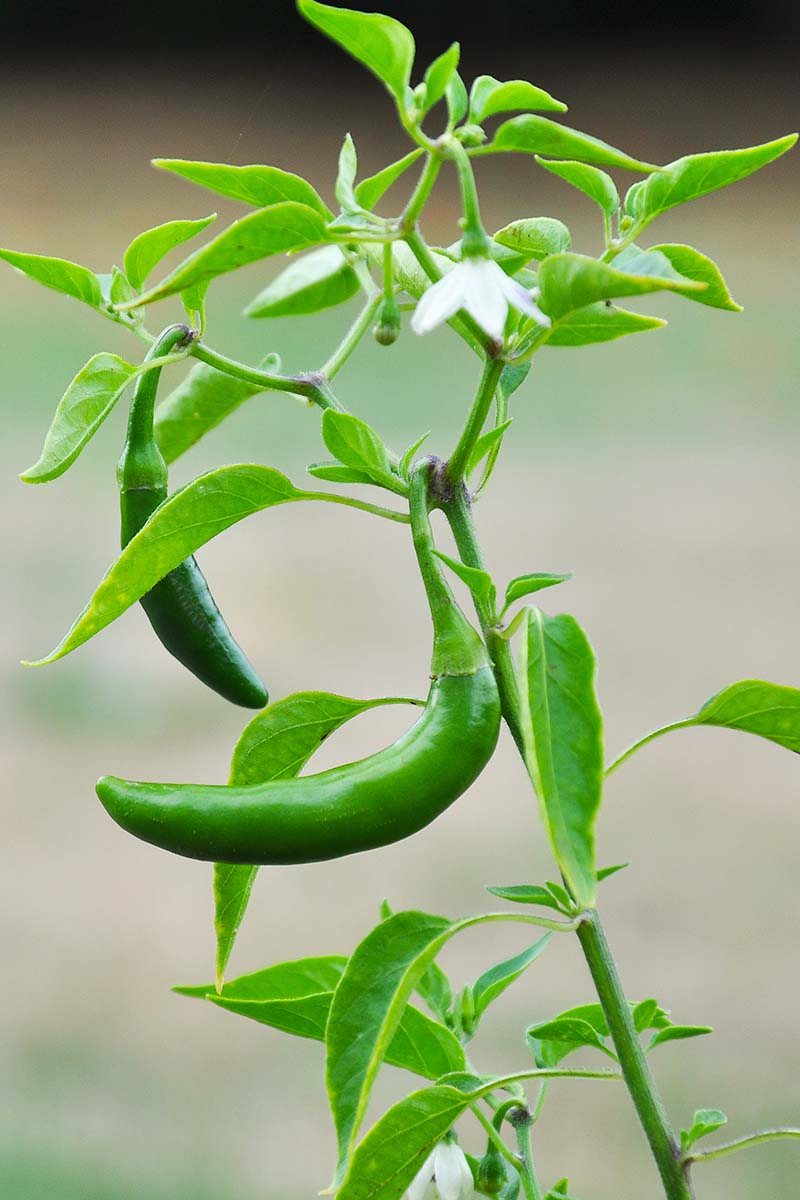
That doesn’t mean you must pull the plant. If you particularly love the one you have, keep it growing, but temper your expectations and maybe plan to save seeds from the fruits so you can continue its legacy.
If you find your plants are starting to lean or droop, attach stakes around them for support.
Feel free to pinch the growing shoots to encourage bushier growth. This isn’t necessary for a nice harvest, but you can influence the shape of the plant through pinching.
Peppers grown as annuals can be removed from the garden and composted at the end of the season, with the arrival of first frost.
Cultivars to Select
Often, you’ll simply find these plants sold under a generic name.
For instance, Eden Brothers has heirloom seeds available in small packets, one ounce, or quarter-pound containers.
But if you keep an eye out, there are several hybrids and cultivars available as well that can offer you some different options.
Balin
‘Balin’ serrano peppers are tiny. They reach just over an inch long and never more than half an inch wide.
The term “balin” means bullet, and it’s also another name that you might see dried serranos labeled under.
NuMex CaJohns Serrano
This cultivar is huge, with a capital H. Bred at the Chili Pepper Institute in New Mexico, it reaches at least four inches long, but often several inches longer.
The pods are about an inch wide at the widest spot and the plant is extremely high-yielding.
However, this isn’t the plant for you if you’re looking for spice. The fruits top out around 5,000 SHU, making them closer to a jalapeno in terms of heat level.
Purple
Yes, this one stands out because the fruits are deep, dark purple, but they’re also longer and thinner than the standard serrano.
You must let the peppers mature on the plant to attain that dark color. Otherwise, pick them when they’re green – they’re still delicious.
Serrano del Sol
If you’re hoping for some peppers early in the season, this hybrid is a good option.
The lateness of ripening is one of the big complaints gardeners often have about serranos, but these fruits are ready starting just two months from planting. The plants are high-yielding as well.
Tampiqueno
Bred in Guanajuato, Mexico, this heirloom has medium-spicy, petite fruits that stay under two inches long. You can start harvesting in about 75 days.
True Leaf Market carries this classic in various packet sizes ranging from one gram to five pounds of seed.
Managing Pests and Disease
Apparently, deer, rabbits, and other herbivores don’t appreciate the spice of chilies in the same way that humans do.
In fact, that’s probably the main reason peppers evolved to contain capsaicin in the first place. It discourages herbivores from taking a bite and preventing the plant from reproducing.
The fact that these plants have been spread across the globe by humans is often due to the fact that they do contain capsaicin, so it was an unintentionally successful evolutionary trait in that sense. But I digress.
Birds
Herbivores have pain receptors that make eating chilies unappealing (unless you’re a human who has learned to love spice, of course). But birds don’t have that pain receptor, and they can eat peppers without feeling the burn.
While this helps the peppers spread their seeds, it’s not ideal for those of us who would like to eat the fruits before the birds do.
If you find birds are stealing the young peppers before you can get to them, try covering your bushes in netting.
Most of the time, however, birds won’t make too big of a dent in your harvest, so just keep an eye on the situation and be ready to act if necessary.
Pests
You were probably hoping that if herbivores don’t like chilies, pests might not like them either. No such luck. Not only do several types of insects love to devour pepper plants, but they can also spread disease.
Aphids
Aphids are common on pepper plants and there are many species of aphids that feed on them. Aphids are sap-sucking pests in the superfamily Aphidoidea. If you’ve gardened much, you’ve probably come across them at least once before.
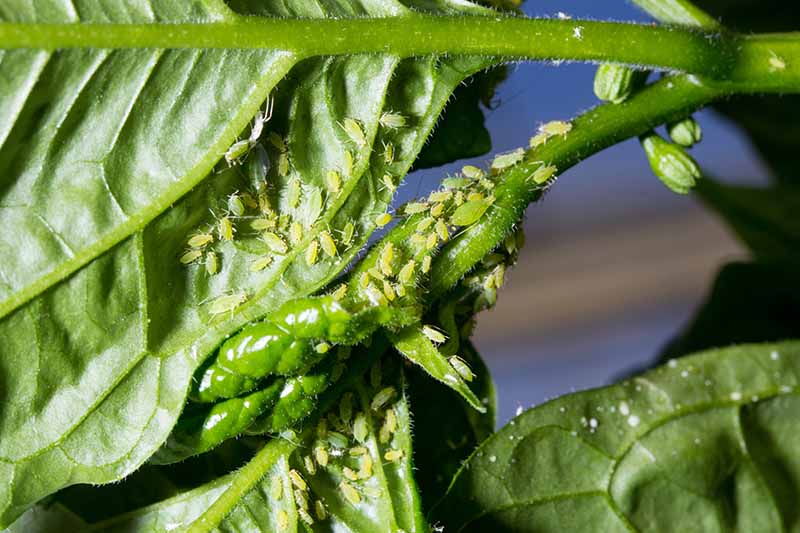
In peppers, you’ll notice yellowing leaves and a sticky honeydew on the stems and foliage.
Read our guide to learn how to identify and eliminate aphids.
Flea Beetles
Flea beetles (family Chrysomelidae) love plants in the Solanaceae family. That includes things like eggplants, tomatoes, and, yes – peppers.
They are tiny, shiny, black beetles that chew little shot holes into the leaves of the plant, which can reduce vigor and introduce disease.
Head to our guide to learn more about controlling flea beetles.
Spider Mites
Pepper plants like it warm and dry. Unfortunately, so do spider mites.
You probably won’t notice the tiny insects on your plants. Instead, you might see the webbing they leave behind, and yellowing leaves.
When enough of them are present, this causes severely stunted growth and may even prevent fruits from fully developing.
Learn more about spider mite control here.
Need more help? Check out our guide to pepper plants pests.
Disease
I find pests to be a more common problem with serranos than disease. But pests won’t usually kill your plant, and diseases can.
Damping Off
Damping off is something pepper plants may experience when they’re young. Either the seeds won’t germinate at all, or the seedlings will be weak, and collapse. You might notice a dark, water-soaked stem just above the ground.
It’s caused by several different types of fungi and water molds (oomycetes), including Pythium and Rhizoctonia species. Check out our guide to understand why damping off happens and how to prevent it.
Mosaic Virus
Pepper mosaic virus (PMMoV) is caused by tobacco viruses in the Tobamovirus genus.
The plants can also be impacted by cucumber mosaic virus (CMV) and tomato spotted wilt virus (TSWV). Regardless of the specific pathogen that strikes, the symptoms all look the same.
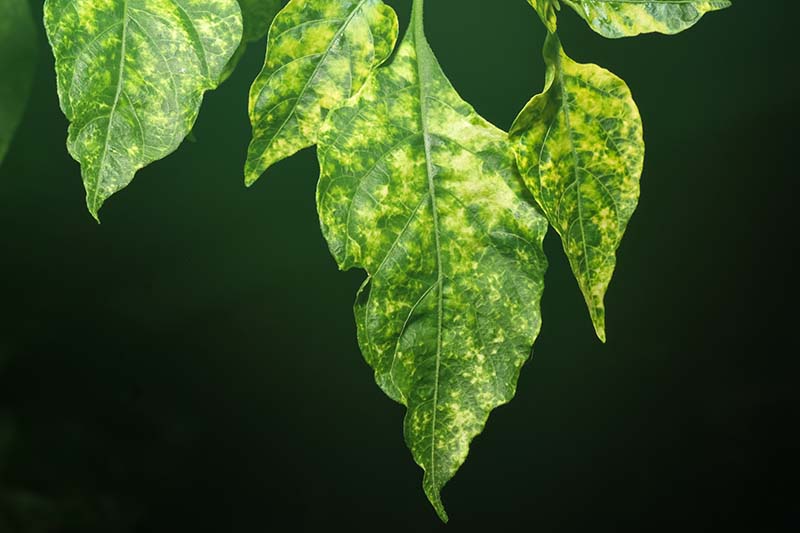
Leaves will have yellow, angular blotches and slightly puckered sections. The fruit will have unusual lumps and bumps. Once plants are infected, there’s nothing you can do.
Prevent disease by keeping insects like aphids away, because they can carry these viruses. They can also be carried on contaminated seed, clothing, or tools. That’s why it’s important to practice good garden hygiene.
Powdery Mildew
Powdery mildew is commonly seen in many different species of plants. It’s caused by fungi in the order Erysiphales and results in a powder-like coating on the leaves of infected plants.
It can be spread in a number of ways, by aphids, moisture, and wind, to name a few. Stressed plants are particularly vulnerable.
Read our guide to powdery mildew for more information on how to identify and control this disease.
Harvesting
Do you know how sometimes you bite into a pepper and it’s perfectly spicy, but you try another from the same plant and it blasts your taste buds into outer space?
There are several factors that can alter the heat of a chili on the same plant, but the position on the branch is one of the major contributing factors.
The fruits on the first node are the least spicy, with those on the second node being spicier.
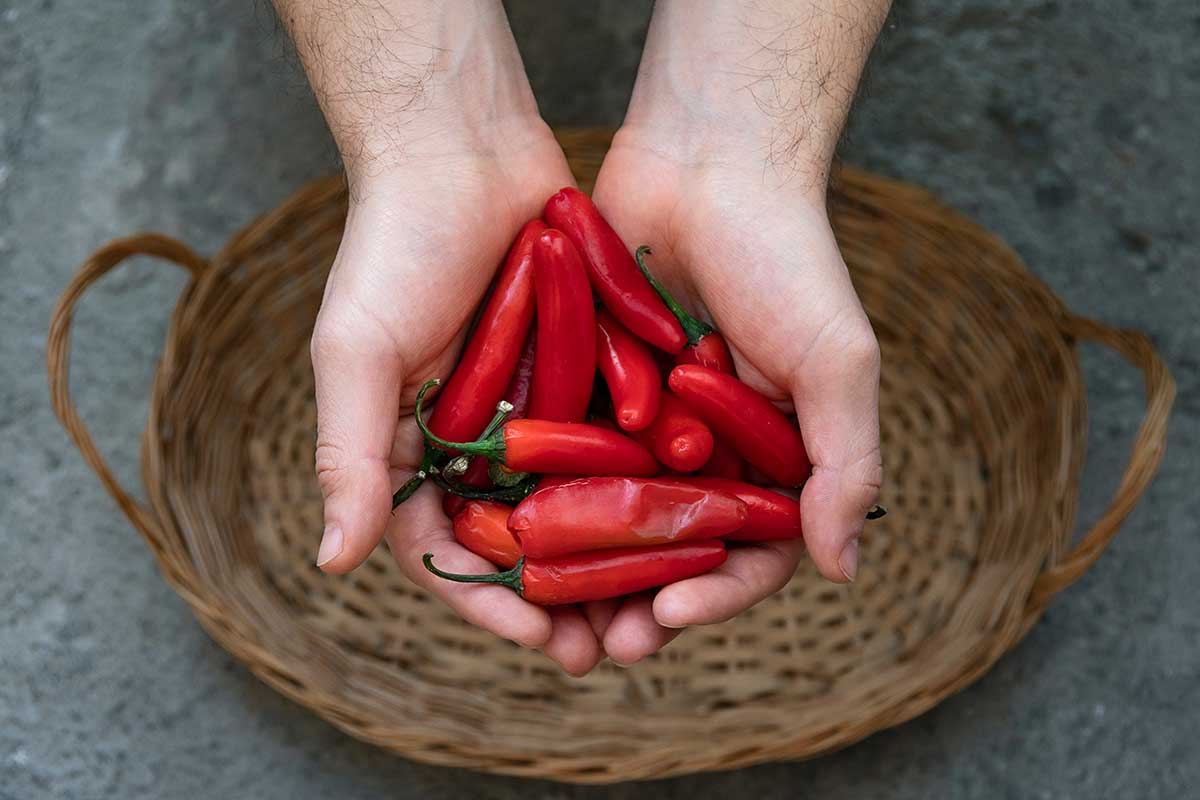
If you have varying levels of heat preference, sort your peppers as you pick them according to the node they came from. I’m happy to provide my address if you want to keep the ones from the first node and send those spicier suckers my way.
To harvest, gently pull the peppers by hand. They should come away easily if they’re ready. You might need to use scissors or clippers if you’re harvesting them a bit before they’re fully mature.
Make sure to leave plenty of stem attached if you want to hang them to dry.
The peppers might not all mature at the same time, so keep an eye on things and pick them individually when they seem ready. Use the number of days to maturity for your selected cultivar as a guide, and check your plants regularly.
Preserving
You can dry serranos, but the thick flesh means this will take a while.
The traditional method involves threading string through the stems and hanging the peppers in a warm area with good air circulation. Leave a bit of space between the peppers and allow them to dry for up to a month.
You can speed up the process by using a dehydrator or placing the peppers in a single layer on a cookie sheet and baking them at the lowest temperature your oven can provide until they feel light and dry to the touch, turning them as needed so they’ll dry evenly.
Find more tips in our guide to dehydrating garden produce.
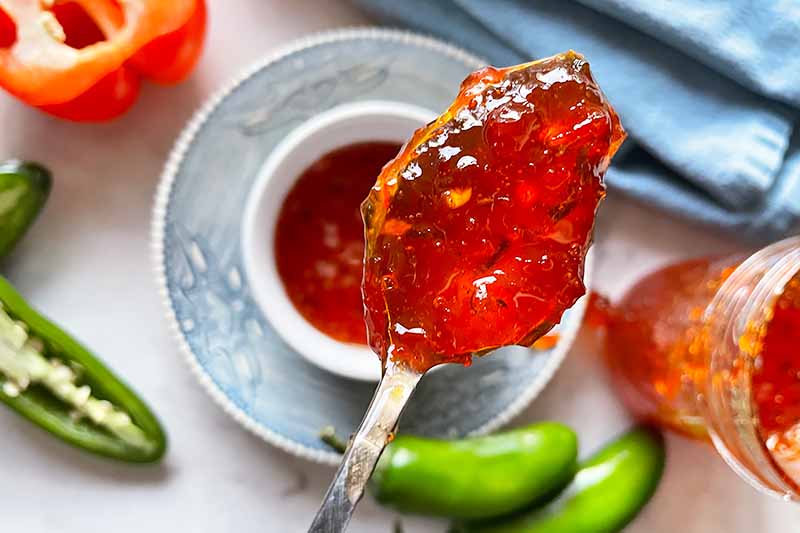
Serranos are ideal for pickling. They are also magical when made into jelly. Our sister site Foodal has an excellent recipe for jalapeno jelly that you should try. Just use serranos instead.
Serranos are a classic ingredient in giardiniera or serranos en escabeche, which are traditional recipes for mixed pickled vegetables.
Recipes and Cooking Ideas
You may have heard that the heat is contained in the seeds of peppers. That’s not technically correct.
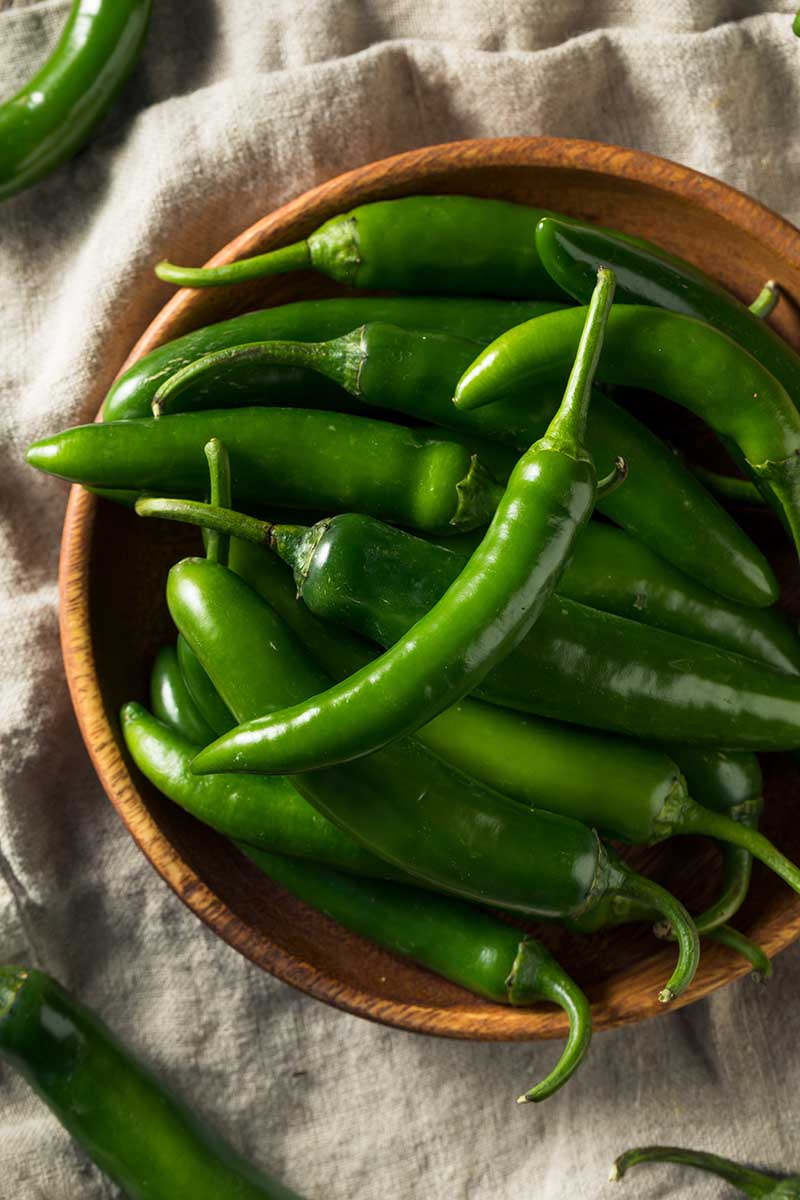
The capsaicin is concentrated in the placenta, though some is found throughout the entire fruit. The placenta is the white part that runs down the center of the pepper and that all the seeds are attached to.
So if you sample a serrano and find that it’s a bit too hot for your liking, scrape away some (or all) of this placenta and you’ll dramatically reduce the amount of spice.
You can’t eliminate all of the spice in a pepper this way, because there’s capsaicin throughout, but if you didn’t want any spice you would have grown bell peppers, right?

The seeds aren’t super bitter and they’re fairly tender, so there is no need to remove them if you don’t want to. In Mexico, the seeds are rarely removed when they’re used in a recipe.
I don’t know if a pepper a day keeps the doctor away, but if it does, I am never going to see my physician again. I eat a serrano every morning in my oatmeal.
Now, stay with me, because I know that sounds strange. But I’m about to share my husband’s super-secret savory pepper oatmeal recipe with you.
He makes this anytime we have guests stay over or when we visit someone, and they always rave about it. To make it at home, gather:
- 1/4 cup steel-cut oats
- 1 cup water with 1 tsp. broth concentrate added (or 1 cup broth)
- 1 serrano chili, chopped
- 2 cooked breakfast sausages, chopped (optional)
- 2 ounces medium cheddar cheese, shredded
Simmer the oats in the broth (or water with concentrate) in a pot, stirring regularly, until the oats are just slightly thinner than your desired consistency.
Turn the heat off but leave the pot on the burner. Put all the other ingredients in and stir until the cheese is melted.
You can add anything else that sounds good to this, so don’t feel constrained. When we forage mushrooms in the fall, we toss those in.
Caramelized leeks or onions are crazy good additions to use during the winter. Chopped tomatoes are lovely in the summer.
We also top the cooked oatmeal with chopped baby arugula, chives, or cilantro now and then.
In Mexico, they’re an essential part of salsa verde, made with tomatillos.
Try blistering them over an open flame. All you need to do is brush them with oil, roast them over a flame until the outside is just charred and blistering, and sprinkle with salt before serving.
You can use serranos in your cooking anywhere you’d use jalapenos. I love them in guacamole, Mexican rice, and ceviche.
Quick Reference Growing Guide
| Plant Type: | Perennial vegetable (grown as an annual) | Water Needs: | Moderate |
| Cultivated in: | Mexico | Maintenance: | Low |
| Hardiness (USDA Zone): | 9-12 | Tolerance: | Heat, some drought |
| Season: | Summer | Soil Type: | Organically rich, sandy |
| Exposure: | Full sun | Soil pH: | 6.0-7.0 |
| Time to Maturity: | 70 days | Soil Drainage: | Well-draining |
| Spacing: | 18 inches | Companion Planting: | Cucumbers, marigolds, melons, onions, squash |
| Planting Depth: | 1/4 inch (seeds), depth of root ball (transplants) | Avoid Planting With: | Broccoli, brussels sprouts, kale, other peppers to avoid cross-pollination |
| Height: | Up to 5 feet | Family: | Solanaceae |
| Spread: | 1-2 feet | Genus: | Capsicum |
| Growth Rate: | Moderate | Species: | Annuum |
| Pests & Diseases: | Birds; aphids, flea beetles, spider mites; damping off, mosaic virus, powdery mildew | Cultivar: | Serrano |
Serranos Add Pep to Your Garden
Serranos are versatile peppers, which is why they should be a staple in your veggie garden. Plus, growing them yourself gives you a measure of control over how spicy they are when you harvest them.
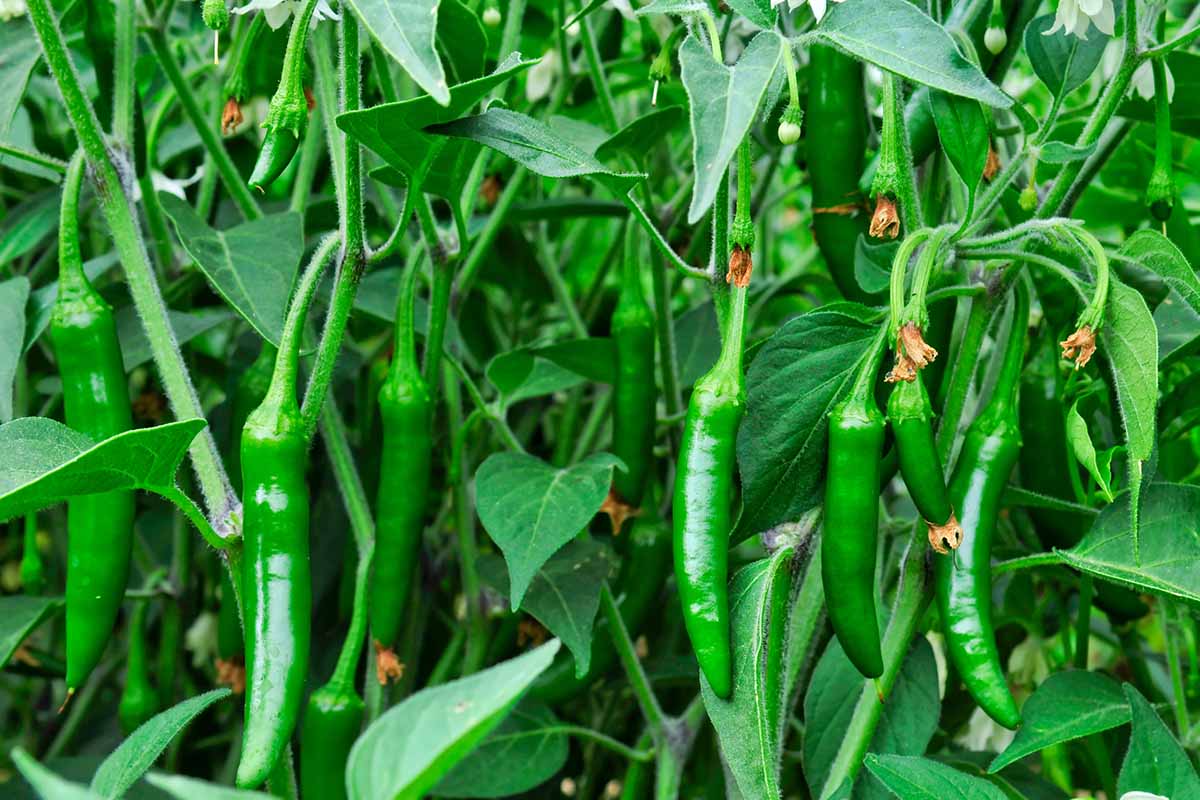
And you know there’s nothing better than plucking a pepper off the plant and popping it into your mouth while it’s still warm from the sun.
How do you intend to use up your serrano bonanza? Let us know in the comments.
I hope that this guide helped you feel confident about growing these marvelous plants. If you’re interested in growing other peppers, you might be interested in these articles:
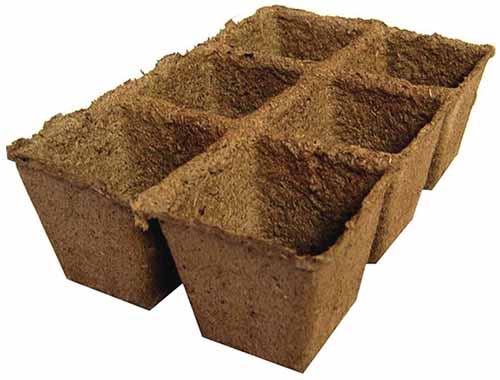

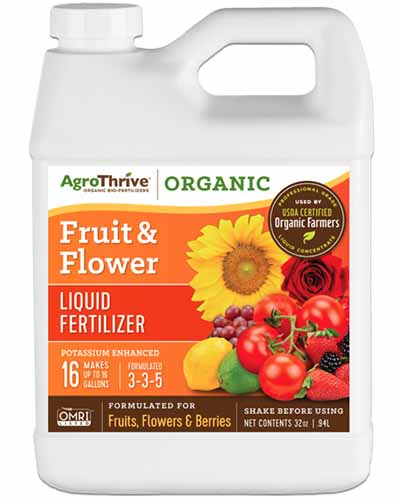
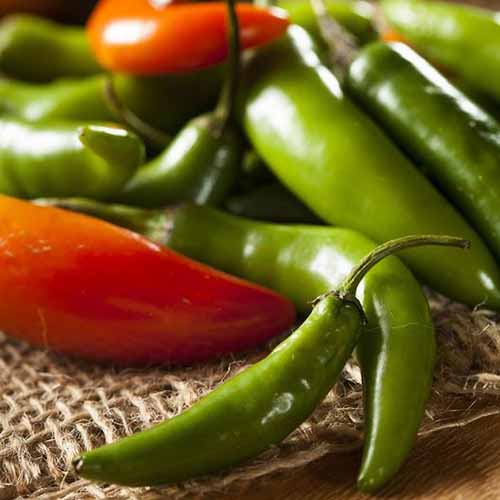
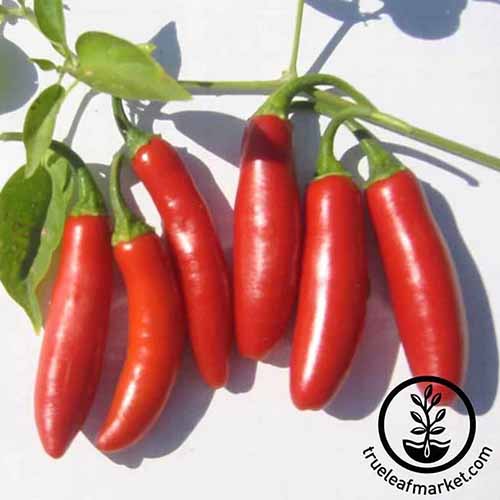
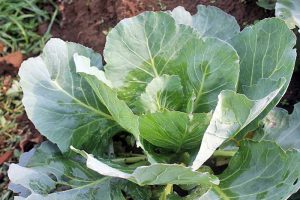
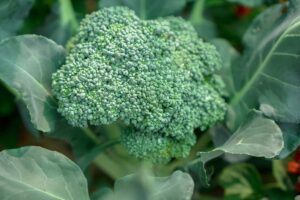
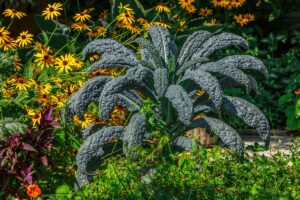
Serrano works well in Pico de Gallo mix.
Yum!